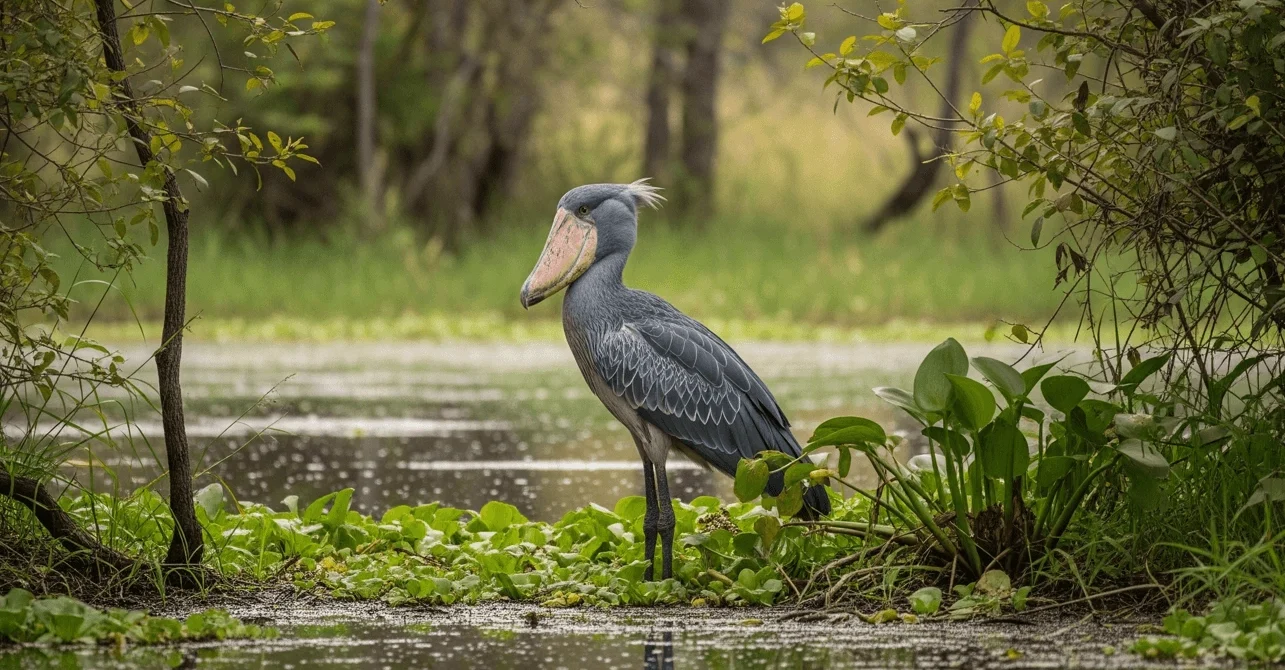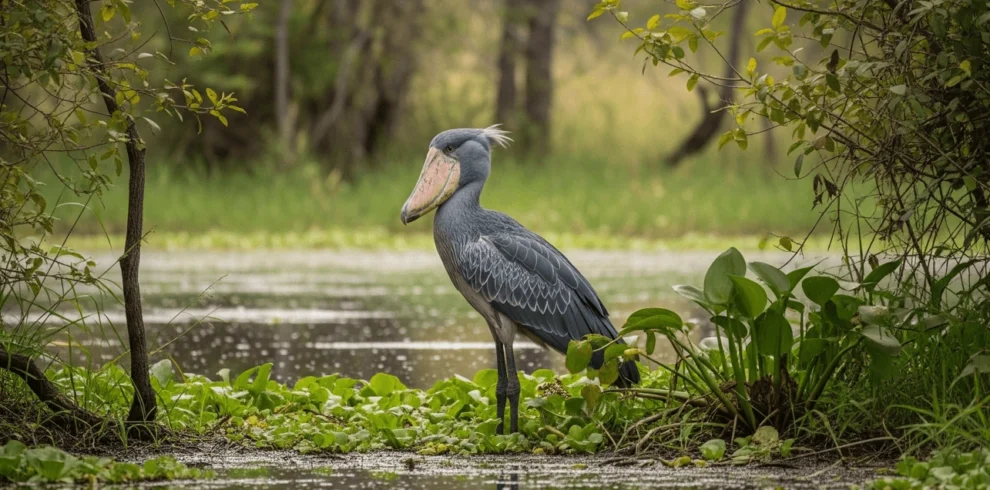“Birds are the last true descendants of dinosaurs — and the Shoebill? It’s a prehistoric superstar.”
Welcome to Mabamba Swamp, a place where time slows, binoculars lift, and jaws drop. Just 12km west of Entebbe, this Ramsar-listed wetland quietly claims its place among the world’s most thrilling birding destinations.
Whether you’re an avid birder or simply someone who appreciates rare beauty in raw, wild form, Mabamba will pull you in — and hold you there.
Key Takeaways
- Mabamba Swamp is the best place in Uganda to spot the rare and legendary Shoebill Stork.
- The wetland hosts 300+ bird species, making it a must-visit for birders.
- Shoebill viewing is typically done via guided canoe or motorboat, but nature walks add a deeper layer.
- Just 45 minutes from Entebbe — ideal for pre- or post-safari excursions.
- Combine with a nature hike and lunch at Nkima Forest Lodge for a full day of slow, immersive travel.
What Makes Mabamba So Special?
First: the Shoebill. It’s what most travelers come for — and rightly so. This massive, dinosaur-like bird is incredibly elusive in most parts of Africa. But not here. In Mabamba, your odds of seeing one are high. Some mornings, they seem to pose for the camera.
But there’s more. This isn’t just a Shoebill sanctuary — it’s a biodiversity goldmine. Think open water channels flanked by papyrus walls, alive with herons, jacanas, kingfishers, and the haunting call of the African fish eagle.
BirdLife International designated Mabamba an Important Bird Area, and in 2006, it was named a Wetland of International Importance by the Ramsar Convention — the highest ecological honor a wetland can receive.
Where Is Mabamba Swamp?
You’ll find Mabamba on the northern shores of Lake Victoria, about 12km west of Entebbe. The journey from Entebbe takes roughly 45–60 minutes by road, or less if you’re crossing by boat from the Entebbe side.
It’s close. It’s convenient. And it feels worlds away.
Shoebill Spotting: How It Works
Most visitors explore Mabamba in a dugout canoe or motorized boat, guided by expert birders who know how to read the swamp. Tours typically start early — around 7:00 or 8:00 am — when the Shoebills are most active.
Your guide will navigate slowly through narrow channels of water, scanning the reeds for motionless grey silhouettes. When a Shoebill appears, time freezes. You might get 10 minutes. You might get 30. Either way, it’s pure magic.
This is a prime location for both casual photographers and serious twitchers. You’ll also see:
- Malachite Kingfisher
- African Jacana
- Pied Kingfisher
- Goliath Heron
- Blue-breasted Bee-eater
And many more — over 300 species have been recorded here.
Add-On: On-Land Birding and Nkima Forest Walk
Don’t stop at the boat. One of Mabamba’s most underrated experiences is its on-foot nature walk through cultivated land and into Nkima Forest.
This 1–3 hour guided walk offers:
- A completely different birding experience (think forest species like Great Blue Turaco, Grey Parrot, and Black-and-white Casqued Hornbill)
- Elevated views over the wetland
- A sense of place that goes beyond the swamp itself
End the walk at Nkima Forest Lodge, perched on Nansubuga Hill, where you can relax with a drink or enjoy a hot three-course lunch. It’s serene. Soulful. And one of those hidden spots that somehow never make the guidebooks.
Pricing (Guided Walk):
- 1 person: $30
- 2 people: $20 each
- 3+ people: $15 each
- Lunch at Nkima Lodge: Add $15 per person
Responsible Travel & Community Impact
Mabamba is protected and managed in large part by its own people. The Mabamba Wetland Ecotourism Association — a group of local fishermen, bird guides, farmers, and artisans — ensures the site remains both accessible and protected.
Your visit directly supports:
- Conservation of the wetland and its species
- Livelihoods of community members
- Ecotourism as a viable, sustainable economic model
We encourage all guests to travel consciously: bring eco-friendly bug spray, wear reef-safe sunscreen, and opt for refillable water bottles.
When to Visit Mabamba Swamp
Mabamba is open year-round, but the best time for birding is during the dry seasons:
- June to August
- December to February
During these months, the waters are more navigable, and birds — including the Shoebill — are easier to spot.
Planning a full safari? Check out our guide on the best time for gorilla trekking — many travelers pair Mabamba with a longer Uganda itinerary.
What to Bring
- Binoculars (essential)
- Sunscreen & insect repellent
- A wide-brimmed hat
- Light, long-sleeved clothing
- A good camera with zoom lens
For those planning a longer safari, see our guide on what to pack for gorilla trekking — it covers all the essentials.
Pair Mabamba With Other Uganda Highlights
Mabamba makes a perfect soft landing or send-off if you’re flying in or out of Entebbe. But it’s also a fitting prelude to more wilderness.
Want to get deeper into Uganda’s wild heart? Consider these nearby parks:
- Murchison Falls National Park — for lions, leopards, and the iconic Nile waterfall
- Queen Elizabeth National Park — known for tree-climbing lions and Kazinga Channel boat safaris
- Bwindi Impenetrable Forest — for unforgettable gorilla trekking in Uganda
Mabamba is proof that magic doesn’t always require a long journey or a rugged itinerary. Sometimes, it’s just an hour away from Entebbe, gliding silently through papyrus in search of a bird that looks like it walked straight out of the Jurassic.
If you’d like us to craft the perfect Mabamba experience — whether as a day trip or part of a longer Uganda safari — request a quote and we’ll take care of every detail.
FAQ: Mabamba Swamp
Q: Can I visit Mabamba without a guide?
A: Technically yes, but it’s not recommended. Local guides know where the Shoebills are and enhance the entire experience.
Q: How long does the boat excursion last?
A: Usually 2–3 hours. Add another 1–3 hours if you include the forest walk and lunch.
Q: Is Mabamba suitable for kids?
A: Absolutely. It’s a calm, safe environment and kids often love spotting birds — especially the dinosaur-like Shoebill!
Q: What’s the best time of day to go?
A: Early morning is ideal, between 7:00–10:00 AM, when birds are active and lighting is best.
Q: Do I need a special permit to visit Mabamba?
A: No permit required — just book a guide and you’re good to go.


